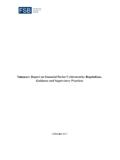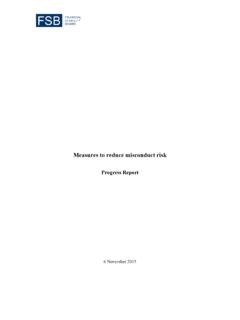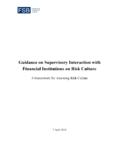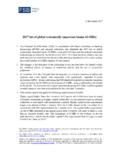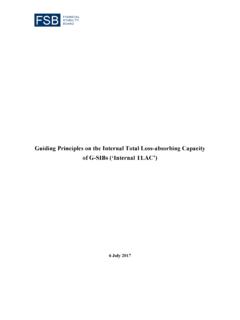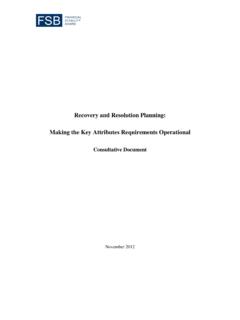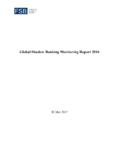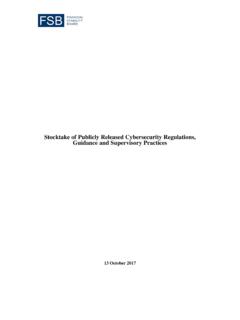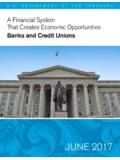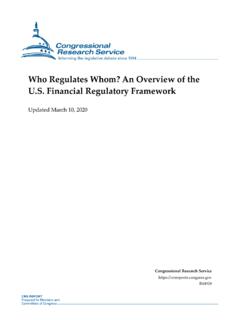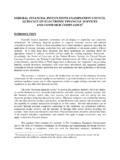Transcription of The Use of Supervisory and Regulatory Technology by ...
1 The Use of Supervisory and Regulatory Technology by Authorities and Regulated Institutions Market developments and financial stability implications 9 October 2020 The financial Stability Board (FSB) coordinates at the international level the work of national financial authorities and international standard-setting bodies in order to develop and promote the implementation of effective Regulatory , Supervisory and other financial sector policies. Its mandate is set out in the FSB Charter, which governs the policymaking and related activities of the FSB.
2 These activities, including any decisions reached in their context, shall not be binding or give rise to any legal rights or obligations. Contact the financial Stability Board Sign up for e-mail alerts: Follow the FSB on Twitter: @FinStbBoard E-mail the FSB at: Copyright 2020 financial Stability Board. Please refer to the terms and conditions iii Table of Contents Executive summary .. 1 1. Introduction .. 3 2. Drivers of SupTech and RegTech developments .. 4 Demand drivers .. 4 Supply drivers.
3 6 3. Benefits, challenges and risks for authorities and regulated entities .. 7 Benefits .. 7 Risks and challenges .. 9 4. SupTech and RegTech strategies, market interaction and monitoring developments .. 11 5. SupTech resource considerations .. 15 6. Data collection, storage, management and analysis .. 18 Data collection .. 19 Data storage .. 21 Data management and processing .. 22 Data analysis and visualisation tools .. 23 7. Applications by authorities.
4 24 8. Applications of new technologies by regulated institutions .. 28 9. Considerations for future policy .. 31 financial stability implications .. 31 Future Technology use by the regulator .. 32 Translating rules into machine-readable format and enabling Regulatory reporting for regulated institutions .. 32 The ethics of using AI models for supervision .. 33 The impact of cloud-based services on the future of supervision .. 34 Collaboration with regulated institutions and other authorities .. 34 10.
5 Considerations for future areas of focus .. 35 Annex 1 Case studies and examples .. 37 Annex 2 List of survey respondents .. 61 Annex 3 Detailed survey results .. 62 Annex 4 Glossary .. 67 Annex 5 References .. 69 iv 1 Executive summary Technology and innovation are transforming the global financial landscape, presenting opportunities, risks and challenges for regulated institutions and authorities alike. A significant area of innovation is the application of new technologies to help authorities to improve their Supervisory capabilities known as SupTech --- and by institutions to meet their Regulatory requirements known as RegTech.
6 The opportunities offered by SupTech and RegTech have been created by a combination of factors that have come to the fore in recent years. These include the substantial increase in availability and granularity of data, and new infrastructure such as cloud computing and application programming interfaces (APIs) which allow large data sets to be collected, stored and analysed more efficiently. Authorities and regulated institutions have both turned to these technologies to help them manage the increased Regulatory requirements that were put in place after the 2008 financial crisis.
7 SupTech and RegTech tools could have important benefits for financial stability. For authorities, the use of SupTech could improve oversight, surveillance and analytical capabilities, and generate real time indicators of risk to support forward looking, judgement based, supervision and policymaking. For regulated institutions, the use of RegTech could improve compliance outcomes, enhance risk management capabilities and generate new insights into the business for improved decision-making. For both authorities and regulated institutions, the efficiency and effectiveness gains, and possible improvement in quality arising from automation of previously manual processes, is a significant consideration.
8 Given these benefits, it is not surprising that SupTech is a strategic priority for an increasing number of authorities. Based on a survey of FSB members, the majority of respondents had a SupTech, innovation or data strategy in place, with the use of such strategies growing significantly since 2016. The most common use cases reported by authorities for SupTech tools were in the areas of Regulatory reporting and data management. The use of SupTech for misconduct analysis and microprudential supervision has increased in recent years, whereas use cases for market surveillance were reported as having reduced somewhat.
9 Over half of survey respondents reported having a formal development or testing platform for SupTech tools. Artificial intelligence applications were the most commonly deployed SupTech tool and were expected to remain so into the future. FSB members reported that the growth in SupTech strategies could be explained by both supply and demand side drivers. The potential for gains in efficiency and effectiveness of Regulatory processes, and the possibility for improved insights into risk and compliance developments were, by a large margin, the most commonly cited demand side drivers for SupTech strategies.
10 On the supply side, the most frequently mentioned drivers were the development of data strategies, increased availability of AI techniques, and emergence of machine-readable data. Despite the opportunities and benefits of SupTech and RegTech, authorities are vigilant to possible risks that could arise from the use of such technologies. Survey responses indicated that the risk reported to be of greatest concern was around resourcing, followed by concerns around cyber risk, reputational risk and data quality issues.

